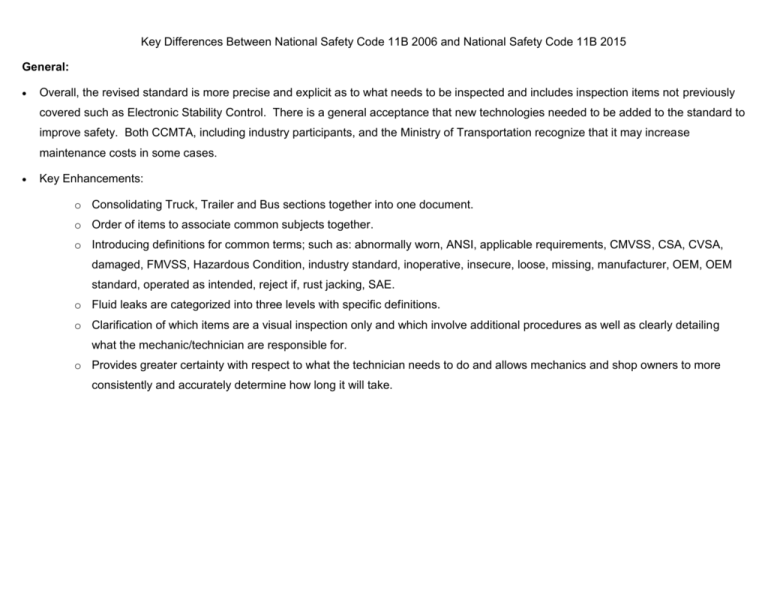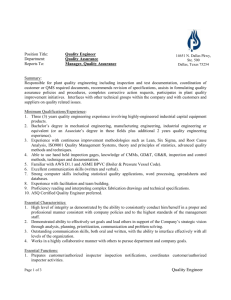DRAFT - TMTA London
advertisement

Key Differences Between National Safety Code 11B 2006 and National Safety Code 11B 2015 General: Overall, the revised standard is more precise and explicit as to what needs to be inspected and includes inspection items not previously covered such as Electronic Stability Control. There is a general acceptance that new technologies needed to be added to the standard to improve safety. Both CCMTA, including industry participants, and the Ministry of Transportation recognize that it may increase maintenance costs in some cases. Key Enhancements: o Consolidating Truck, Trailer and Bus sections together into one document. o Order of items to associate common subjects together. o Introducing definitions for common terms; such as: abnormally worn, ANSI, applicable requirements, CMVSS, CSA, CVSA, damaged, FMVSS, Hazardous Condition, industry standard, inoperative, insecure, loose, missing, manufacturer, OEM, OEM standard, operated as intended, reject if, rust jacking, SAE. o Fluid leaks are categorized into three levels with specific definitions. o Clarification of which items are a visual inspection only and which involve additional procedures as well as clearly detailing what the mechanic/technician are responsible for. o Provides greater certainty with respect to what the technician needs to do and allows mechanics and shop owners to more consistently and accurately determine how long it will take. Key Differences Between National Safety Code 11B 2006 and National Safety Code 11B 2015 Section General General General 1-3 1-11 Changes to NSC 11B from 2006 to 2015 Impact to Ontario New Concept Measurement tolerances are introduced. These tolerances are applied to all measurements in the standard based on the level of accuracy required. New Concept Criteria involving a maximum area expressed in mm2 (e.g. 7600 mm2) such as the maximum size hole in a body section, seat cover, etc. has been changed to a maximum diameter across a hole in order to make it easier for the technician to determine compliance. New Concept Not always listing measurements in metric and imperial. Outlining tolerances better clarifies the level of accuracy needed for a measurement, which in turn determines the tools used. Adds clarity; no impact on compliance. New item for inspection Parts of the vehicle emissions control system can’t be removed. If the malfunction light is on; the technician is required to add a note to the inspection report but it is not a fail criteria. New item for inspection Hybrid power train system. There is an exemption for vehicle owners who provide proof of regular maintenance on this system. Where common inexpensive tools such as tape measures and rulers are used dimensions are stated in metric only with no imperial equivalent. Where more expensive tools are required and to accommodate shops that do not have such tools incremented in metric measure dimensions are stated in metric with an imperial equivalent. In Ontario, Drive Clean is used to enforce the emissions control system is working. A vehicle will only fail the inspection if parts have been removed. The standard advises that only qualified technicians can inspect this system. There is an exemption for the vehicle owners that can prove there is regular maintenance on this system. Key Differences Between National Safety Code 11B 2006 and National Safety Code 11B 2015 Changes to NSC 11B from 2006 to 2015 Section 1-13 2 3 3 New inspection criteria 2-tiered alternate fuel systems inspection: First level of inspection is a general inspection intended to be completed by any technician. Second level is more detailed. This level of inspection is intended for jurisdictions without a separate inspection program for fuel systems. Reorganization of suspension section: Consolidated the different suspension types with more general inspection criteria. Reorganization of the braking sections in three parts with five types of brake inspection: 3 – introduction 3H – hydraulic and other non-air brake systems 3A – air brake systems Limited Brake Inspections (LBI): Only lining thickness of either the brake shoe or pad is required to be measured and recorded on a limited inspection. PMVI 2015 – allows for a limited brake inspection with proof of a previous internal brake inspection for the following timelines: o Truck drum brakes – 19-months (resulting in every other annual inspection). o Truck disc brake – 7-months (resulting in every annual inspection). o Bus drum brakes – 7-month (resulting in every other semi-annual inspection). o Bus disc brakes – 7-months (resulting in every other semi-annual inspection). Impact to Ontario In Ontario, these systems are inspected by Technical Standards and Safety Association (TSSA). Ontario will only use the first level of inspection. It has been confirmed by the Ministry of Training Colleges and Universities that the first level of inspection can be completed by any technician without specialized training. More comprehensive inspection for suspension types. Reorganization and clarification of the wording is an improvement to the standard. This section was previously very confusing and contradictory. If a truck meets the qualifications for a limited brake inspection only limited brake measurements are required. Resulting in a reduced inspection time and unnecessary removal of wheels and drums when no visible defects are found. Buses will continue to be prohibited from using the limited brake inspection. Key Differences Between National Safety Code 11B 2006 and National Safety Code 11B 2015 Section 3H-17 Changes to NSC 11B from 2006 to 2015 ABS system must function on all vehicles manufactured with ABS. Impact to Ontario PMVI 2006 – required ABS on vehicles where it was manufactured on or after April 1, 2000. 3A REMOVED – cam rotation test to assess drum diameter. 3A-19 3A-20 New item for inspection Require to test the PLC communication system for both a truck and trailer for a trailer inspection. The trailer must be able to send an anti-lock brake system (ABS),fault code to the truck and the truck’s PLC system must be able to receive it and display a warning lamp. New item for inspection Check the functionality of Electronic Stability Control (ESC) systems. REMOVED – requirement for a valid and correct manufacturer’s federal compliance label. New item for inspection Check auxiliary fuel burning heaters. New inspection criteria Check wheelchair anchors and wheelchair occupant restraint systems. 3A-21 3A-22 5 5-9 5-15 Regardless of manufacturing date if the vehicle is equipped with ABS it has to work. This increases the number of vehicles that require working ABS. Ontario is considering an exemption for vehicles manufactured before April 1, 2000 or providing a two year transition period. Regulation 611 prohibited the use of this test already, therefore no impact. Considered an important test for safety. This requires MVIS location to purchase a new tool or to hook the trailers to a truck to complete this test. Minimal impact for inspection stations as they are only required to complete a diagnostic light test. Vehicle owners will now be required to maintain the ESC systems on their vehicles, previously not required. Ontario is supportive of this requirement being removed. Additional safety criteria. Not believed to add time or much effort. New requirement in NSC 11B but was already required in Ontario under Regulation 611. Key Differences Between National Safety Code 11B 2006 and National Safety Code 11B 2015 Section 6 6-1 6-13 8-13 Changes to NSC 11B from 2006 to 2015 New inspection criteria Check requirements related for CSA D250 standard for school buses. New inspection criteria All LED elements must work on headlamps. New inspection criteria Windshield cannot have a crack longer than 50 mm anywhere in swept area of windshield wipers. NSC 11B 2006 Prohibited all aftermarket tinting. NSC 11B 2015 Prohibits aftermarket tinting on windshields and permits light transmittance 70% on the windows to the direct left and right windows of the driver. 8-17 8-21 8-24 Impact to Ontario New inspection criteria Limit the size of external sun visors. Cannot extend more than 150 mm below the upper edge of the windshield and overlaps the portion of the windshield swept by the OEM wiper arm and wiper blade. New inspection criteria 210 mm maximum distance from the bottom of the mud flap to the ground. New item for inspection aerodynamic devices. These new requirements will require the MVIS technician to have knowledge of school buses. D250 is already an on-road standard in Ontario but now mechanics/technicians will to need to understand and use certain, specified portions of the D250 when conducting the annual and semi-annual inspections. Increased requirement for headlights only; previously no more than 25% could be burnt out. Previous criteria was subjective – “so as to restrict vision”. With the adoption of NSC 11B 2006 Ontario modified this requirement by having it only apply to vehicles manufactured after July 1, 2011. This modification will stay in place. The allowance for 70% light transmittance may require some MVIS locations to purchase a tint meter at a cost of $75 -$150 in order to measure compliance. Ontario will exempt all vehicles from this requirement. No impact. Visual inspection only to ensure it is secure and not torn or a hazard. Key Differences Between National Safety Code 11B 2006 and National Safety Code 11B 2015 Section 9-1 9-2 9-4 10-5 Changes to NSC 11B from 2006 to 2015 New reject criteria for Tire Tread PMVI 2006 (using rear tires as an example) Reject if less than 1.6 mm (2/32) of tread depth remains when measured in any two adjacent major tread grooves at three separate locations on the tires or any flat spots or cupped to wear bars or tread is less than 1.6 mm on rear tires. PMVI 2015 Tread depth is less than 2 mm in a major tread groove. REMOVED – no retreads on rear tires of buses. The former restriction for retreads on single rear tires of buses was deleted. However, retreads are still not permitted on the steer axle of any vehicle. New inspection criteria for Inflation of Tires Added specific limits regarding over or under inflation of tires – 10% tolerance. Based on recommended pressure of vehicle or tire manufacturer. Added requirements regarding roll-coupling hitch. Impact to Ontario Tire tread depth requirements have been simplified and now use metric measure as the principle dimension. New requirement is to measure one spot (flattest spot) instead of six. Accommodate a greater use of retread tires where it is safe to do so. Removes ambiguity regarding what is considered over or under inflated. This type of hitch was previously inspected by without any specific requirements. Not believed to be additional time or effort.


